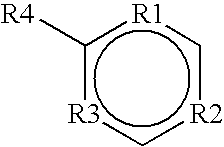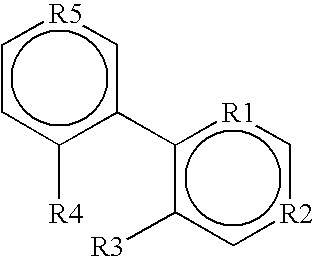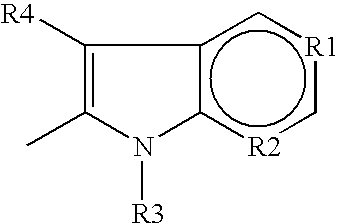Use of cannabinoid receptor agonists as hypothermia inducing drugs for the treatment of ischemia
a cannabinoid receptor and ischemia technology, applied in the field of compounds for the induction of hypothermia, can solve the problems of serious infections, brain damage or death, mechanical inducers of hypothermia have considerable unwanted side effects, etc., and achieve the effect of inducing hypothermia in human beings
- Summary
- Abstract
- Description
- Claims
- Application Information
AI Technical Summary
Benefits of technology
Problems solved by technology
Method used
Image
Examples
example 1
Cardiac Arrest
[0173]A 57-year-old woman is brought into hospital 21 minutes after having collapsed without warning. Staff at the emergency room is alerted in advance. The patient is evaluated in the emergency room where the physician in charge decides that the patient shall receive hypothermia therapy immediately to minimize the risk of damage to the brain and other tissues. An intravenous bolus injection of HU-210 (e.g. 100 microgram / kg body weight) or delta-8-THC phosphate (e.g. 40 mg / kg body weight) is administered.
[0174]The purpose of hypothermia therapy is to lower the patient's core body temperature to 32-34 degrees Celsius for 12 to 24 hours (current American Heart Association recommendation). Depending on the individual's response to the medication 1-4 additional intravenous bolus injections may be required (HU-210: Additional injections of 20-100 microgram / kg body weight; delta-B-THC phosphate: Additional injections of 8-40 mg / kg body weight). Additional bolus injection may...
example 2
Perinatal Asphyxia
[0176]A newborn baby suffers cerebral ischemia during delivery as the umbilical cord gets wrapped around his neck. The APGAR score 10 minutes after delivery is 6. The pediatrician decides that the patient shall receive hypothermia therapy immediately to minimize the risk of damage to the brain and other tissues. An intravenous bolus injection of HU-210 (e.g. 100 microgram / kg body weight) or delta-8-THC phosphate (e.g. 40 mg / kg body weight) is administered. Additional bolus injection may be administered after 6-12 hours from the first bolus injection.
[0177]The purpose of hypothermia therapy is to lower the patient's core body temperature to 32-34 degrees Celsius for 12 to 24 hours (current American Heart Association recommendation). Depending on the individual's response to the medication 1-4 additional intravenous bolus injections may be required (HU-210: Additional injections of 20-100 microgram / kg body weight; delta-8-THC phosphate: Additional injections of 8-40 ...
example 3
[0179]A 72-year-old is brought to hospital 1 hour and 30 minutes after waking up with the entire right side of his body feeling numb and weak. The patient is evaluated in the neurology department and the physician in charge decides, suspecting a stroke, that the patient shall receive hypothermia therapy immediately to lessen damage to the brain. An intravenous bolus injection of HU-210 (e.g. 100 microgram / kg body weight) or delta-8-THC phosphate (e.g. 40 mg / kg body weight) is administered.
[0180]The purpose of hypothermia therapy is to lower the patient's core body temperature to 32-34 degrees Celsius for 12 to 24 hours (current American Heart Association recommendation). Depending on the individual's response to the medication 1-4 additional intravenous bolus injections may be required (HU-210: Additional injections of 20-100 microgram / kg body weight; delta-8-THC phosphate: Additional injections of 8-40 mg / kg body weight). Additional bolus injection may be administered after 6...
PUM
| Property | Measurement | Unit |
|---|---|---|
| Time | aaaaa | aaaaa |
| Time | aaaaa | aaaaa |
| Mass | aaaaa | aaaaa |
Abstract
Description
Claims
Application Information
 Login to View More
Login to View More - R&D
- Intellectual Property
- Life Sciences
- Materials
- Tech Scout
- Unparalleled Data Quality
- Higher Quality Content
- 60% Fewer Hallucinations
Browse by: Latest US Patents, China's latest patents, Technical Efficacy Thesaurus, Application Domain, Technology Topic, Popular Technical Reports.
© 2025 PatSnap. All rights reserved.Legal|Privacy policy|Modern Slavery Act Transparency Statement|Sitemap|About US| Contact US: help@patsnap.com



